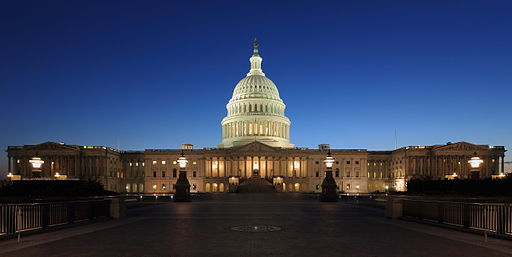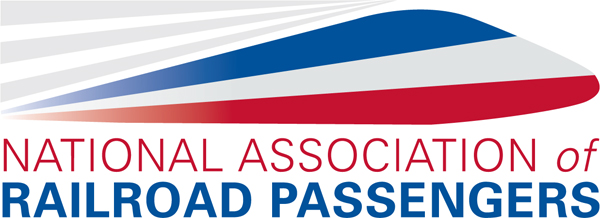Hotline #931
October 2, 2015

Photo by By Martin Falbisoner, via Wikimedia Commons
It went down to the wire, but Congress managed to pass a stopgap government spending bill mere hours before the midnight deadline. However, they settled for kicking the can down the road until December 11, with no real guide on how they are going to handle their legislative priorities, including the DRIVE Act.
According to BNA, members from the House Ways and Means and Senate Finance committees are looking at using one-time revenue from an overhaul of U.S. tax laws to fund the long-term highway and transit bill. This effort would be an alternative to Senate-passed $350 billion, six-year highway bill (H.R. 22), which was supported by NARP.
On the same day, leaders of the House Transportation and Infrastructure Committee unveiled a bill that would extend the Positive Train Control (PTC) installation deadline by three years. Both the Government Accountability Office and the Federal Railroad Administration have said in recent reports that the majority of rail service providers would not meet the December 31, 2015, deadline.
The measure was introduced by House Transportation and Infrastructure Chairman Bill Shuster (R-Pa.) and ranking member Peter DeFazio (D-Ore.) as well as railroads subcommittee Chairman Jeff Denham (R-Calif.) and railroads subcommittee ranking member Michael Capuano (D-Mass.).
The bill would give FRA the authority to offer two one-year extensions on a case-by-case basis for railroads facing challenges after the initial three-year period. Rail companies would have to show FRA a detailed PTC implementation schedule and that they were meeting their goals.
NARP offered its own framework for responsibly extending the deadline for PTC implementation in a statement submitted to the U.S. Senate Commerce, Science, and Transportation Subcommittee on Surface Transportation in February 2015.
House leaders plan to move a standalone PTC extension rather than as a comprehensive transportation bill. That keeps the trains moving—but not much else. “I'd keep your expectations low,” one congressional aide told Bloomberg News.
But NARP knows there’s a better solution: the full Congress must pass the long-term surface transportation bill the Senate passed in July. The DRIVE Act not only contains a reasonable PTC extension, it includes a number of extremely promising provisions that—with the proper funding levels—could be used to build the efficient intermodal transportation network that American businesses will need to compete globally in the 21st Century.
It’s not enough to have more of the same. Tell your elected officials not to settle and push for the passage of the DRIVE Act!
Amtrak’s Chicago Gateway Blue Ribbon Panel issued a final report on recommendations to ease congestion through the nation’s busiest rail hub. The rail congestion through Chicago endangers $799 billion in annual economic activity, impacting six key industries—agriculture and natural resources, automotive, manufacturing, retail, and services—that account for 85 percent of U.S. Gross Domestic Product.
The panel issued a number of targeted recommendations, inducing real-time operational coordination among Chicago’s railroads, coordinated train dispatching, and predictable, dedicated public funding for rail projects that will produce significant passenger and economic benefits.
Untangling Chicago is an imperative step in improving operations on the national passenger rail network. Every day, 56 Amtrak trains depart Chicago Union Station—15 long distance trains and 41 state-supported corridor trains. Chicago Union Station handled 11 percent of Amtrak’s total ridership. Congestion also harms local Metra commuter rail service, which has grown by 50 percent since it began operations in 1984 to become the second busiest commuter rail system in the nation.
NARP will work closely with policy makers to examine the blue ribbon panel’s recommendations. There is a strong need for a federal presence in implementing solutions to Chicago’s rail congestion. As the report amply demonstrates, delays in Chicago railyards have impacts coast-to-coast, for passengers and businesses alike.
NARP is inviting all members in good standing to consider running for seats on the Council of Representatives, the Association's volunteer governing body. Elected members of the Council of Representatives serve two-year terms. The next election for seats on Council will occur in January 2016 for the term starting March 1, 2016. Any NARP member who has paid dues for at least one year, is at least 18-years of age and is a US resident is eligible to run. The certified number of available Council seats to be elected, per state, in January 2016 can be found here.
For more details, please read page 2 of the October 2015 newsletter. NARP is only as strong as the leaders who step up and share their time and talents in working towards our collective goals. Please consider becoming one of these leaders and help make a difference in the future.
High-speed rail was a big topic this week, starting with a new survey by the American Public Transportation Association (APTA) that found 63 percent of Americans are likely to use high-speed trains if they were available today. The likelihood of respondents using high-speed rail for their work and leisure travel increased as they were informed that it will be less expensive than flying and that it will take less time than driving to their destination. The survey also revealed that Americans overwhelmingly support efforts to streamline government regulations that will promote real-estate development near high-speed rail.
The Inverse website has become the latest to try and answer the question of why the U.S. doesn’t have high-speed rail. “Our country’s not really made a commitment to high-speed rail in a big way, at all,” said Andy Kunz, president and CEO of the U.S. High Speed Rail Association. “In fact, we have a lot of forces in this country that are trying to stop it. Mainly, the big industries in transportation who are making money now: big oil, big roads, aviation. Most of those industries do not really want to see a major rollout of high-speed rail all over America because they see that as a huge threat to their businesses.”
The privately owned Northeast Maglev, which wants to bring true high-speed rail between Baltimore and Washington, D.C., has opened an office in Maryland, reports ABC 2. The company has partnered with Central Japan Railway Company (CJRC) to build a train that could take travelers to D.C., in 15 minutes and eventually New York in 45. CJRC has committed to put in $5 billion of the $10 billion needed to fund the project, which has been blessed by Maryland Gov. Larry Hogan (R).
A revised implementation plan for the high-speed rail corridor that could connect the Dallas/Fort Worth Airport area unveiled by the Commission for High-Speed Rail in the Dallas/Fort Worth Region includes a new connection to the Dallas/Fort Worth airport and slower top speeds, reports the Star-Telegram.
A decision to save money by using existing tracks as part of a "blended system" would mean the train's speed would top out at 125 mph -- below the 220 mph originally envisioned. As part of the trade off, a greater population of people will have access to the system. The corridor would bring passengers from downtown Fort Worth to Arlington along the Interstate 30 corridor, then go to the CentrePort-Dallas/Fort Worth Airport area. From there, rail passengers could connect with other transportation to the airport to catch flights. The effort is separate from the privately funded high-speed rail system being developed by Texas Central Partners.
As Hurricane Joaquin barrels through the Caribbean, NJ Transit has a plan to move its equipment to higher ground to avoid a reoccurrence of the damage to 300 of its trains after Superstorm Sandy in 2012, reports NJ.com. NJ Transit was hit with $125 million in flood damage to locomotives and rail cars amid controversy over whether the agency ignored forecasts that warned of the magnitude of the storm. "We have predetermined safe haven locations throughout our system, including Linden and Garwood, to move and store rail equipment from low-lying areas, such as the Meadows Maintenance Complex," said Nancy Snyder, an NJ Transit spokeswoman.
Looking at the bigger picture, NPR station WNYC asked a question: What would it cost to fix all of our transportation infrastructure? “We’re looking at a ballpark of about 400 billion with a 'B',” said Gerry Bogacz, planning director at the New York Metropolitan Transportation Council, a consortium of local governments, just to maintain the system we have and finish improvements underway.
The American Society of Civil Engineers says — in general — the country needs to spend twice as much on transportation infrastructure as we do now to prevent a major loss of income, jobs and gross domestic product. That would mean $800 billion over the next 25 years.
Other areas of the country are also looking at the bigger picture when it comes to transportation, including rail. In New Orleans, State Rep. Walt Leger, a commissioner with the Southern Rail Commission, is pushing to build a passenger rail service route along the Baton Rouge-New Orleans corridor, reports FOX News 8.
The Washington Post asks how many people would ride on the proposed $2 billion light-rail Purple Line, a 16-mile line linking Prince George’s and Montgomery counties, in the Washington suburbs. The Maryland Transit Administration's most recent ridership models predict 58,800 trips in the first year of operation, slated for 2021. That ridership is projected to increase to 74,000 by 2040.
The San Diego Association of Government (SANDAG) has unveiled a 35-year blueprint that would put skyways and light rail stations in some of the county’s beach communities designed to keep cars off the road, reports the San Diego Union-Tribune. The plan envisions $204 billion in transportation spending, half of which would go to public transit like new light rail lines, skyways and buses, with another $5 billion to encourage biking and walking.
On the passenger experience side, Amtrak has taken a page from the airlines and started charging baggage fees, reports Time magazine -- although Amtrak is decidedly more generous in their allowance.
As of October 1, travelers get two personal items up to 25 pounds each, and two carry-ons up to 50 pounds each for free. After that, you can bring two more items for $20 each.
Boston’s MBTA has created a new weekly scorecard that looks at bus or train lines every day and lets riders know if the problem was out of the agency's hands, reports FOX Boston. Chicago’s Metra will begin installing free Wi-Fi on some of its railcars as part of a six-month pilot program, reports ABC 7.
Texas Rail Advocates (TRA) has unveiled an upgraded website with a brand new look; a new logo, new design and new features. In the coming weeks it will feature the latest in freight and rail passenger news, links to all-sites rail, events like the upcoming Southwestern Rail Conference, FAQ’s and factoids on rail issues. Those who registered on the old website will need to re-register on the new one.
Finally, the latest agenda for the upcoming Fall Meeting has been posted on the website. The agenda includes more details on the Amtrak Beech Grove tour, a list of the Saturday panels and the business meeting on Sunday. Please continue to check the website for the very latest updates.
